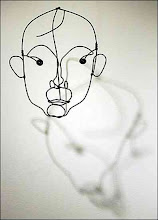When we have close relationships with others—spouses, children, parents, close friends, even pets—those beings become parts of our personalities (or selves, or whatever term you want to use here). That’s not just a bathetic homily, it’s a real issue of what it means to have (to have built over time) a self:
If you seriously believe, as I do and have been asserting for most of this book, that concepts are active symbols in a brain, and if furthermore you seriously believe that people, no less than objects, are represented by symbols in the brain (in other words, that each person that one knows is internally mirrored by a concept, albeit a very complicated one, in one’s brain), and if lastly you seriously believe that a self is also a concept, just an even more complicated one (namely an “I”…), then it is a necessary and unavoidable consequence of this set of beliefs that your brain is inhabited to varying extents by other “I”s, other souls, the extent of each one depending upon the degree to which you faithfully represent, and resonate with, the individual in question. (248)
To boil it down to a ridiculously short summary, we have episodic memories. My episodic memory space, for example, is loaded with information about my wife, my children, my parents, Brian Brennan, Dean Rader, my other friends, my colleagues at work, my dog Moose, my childhood dog Butch, my college mentors, former teammates, etc. What I remember about all of those people and pets amounts to a version of their selves that is constructed in my mind (a self, again, can be thought of as a complex pattern of complex symbols in the brain). Those selves are nowhere near as complex, of course, as the versions of those selves in their own minds. But those versions in my mind are partially constitutive of my mind, and they serve as feedback sources. I might wonder for example, what my wife Abbey will think of this blog post, and I can imagine two or three precise scenarios that might characterize her reactions. These scenarios are not arbitrary guesses; they are based on Abbey’s personality, her behavior, her character, her interests, her reading and research interests, her relationships with Brian, Dean, Moose, our children, etc. Hofstatdter’s question is this—how close is that version of Abbey that exists in my mind to being a “self”? How close is the Abbey in my mind to the Abbey in Abbey’s mind? What about the Brian Brennan in Abbey’s mind? What about the Brian Brennan in my mind? What about the Moose in my mind? Ah….
Does Moose (our five-year-old Chocolate Lab/Newfoundland mix) have a mind? If so, how complex is it as compared to that of a human five-year-old? A human 6-month-old? Hofstatder’s argument is that since there are degrees of symbols in brains, there are degrees of selfhood. A dog certainly behaves based on past experience (whether consciously or not), certainly is able to respond to the mood of an owner, certainly has “personality”; but does a dog have access to episodic memory? And if so, is the dog able to relate a constantly revised self-image to a constantly revised bank of those episodic memories? Clearly not.
So, then, is the “Moose” in my mind more of, less of, or the equal of the “Moose” in Moose’s mind? What if I imagine him being able to think? Then is that Moose more of a “self” than the actual Moose?
When we were in grad school, Brian had a cat named Bosco. Bosco certainly had a personality and Bosco most certainly had become a part of Brian’s identity. In fact, Bosco was such a strong part of Brian’s identity that when Bosco passed away, it took several simultaneous replacement cats to make up for Bosco’s absence. What happened when Bosco passed away? His body died certainly, but the “Bosco pattern” certainly is still active in Brian’s mind and even in my mind. While I was at Brian’s house I briefly saw one of his current cats, and I couldn’t help but project Bosco’s personality onto that cat. Bosco is still acting on my reality and on Brian’s reality; Hofstadter’s wife is still acting on his reality in a far more complex way—so complex that at times he finds himself thinking that he is seeing for her things that she would liked to have seen, or speaking for her, or acting on her behalf in a manner in which she would have acted.
Hofstatder sees this multiplicity of selves as “levels” almost like quantum levels; his argument is (partially) that our episodic memories, self-reflective ability, and our ability to leap among these levels (which amount to feedback loops) combine to create “strange loops” (which have paradoxical elements I won’t get into here) that don't just contribute to our sense of self; they are our sense of self.
At one point during my visit to Norfolk, Brian’s nine-year-old daughter Katharine asked him (referring to me) “Is he your friend or your brother?” We responded almost simultaneously—Brian said “Both, really,” and I said “The answer to your question is ‘Yes’”. But, in fact, we are more than either. Along with our wives, our children, our other close friends and family members, we are a significant part of each other.
As for Brian’s age and his golf game (a "loop", by the way, is a caddie's term for a round of golf), I’ll say only that he shot his age on the front nine.




No comments:
Post a Comment